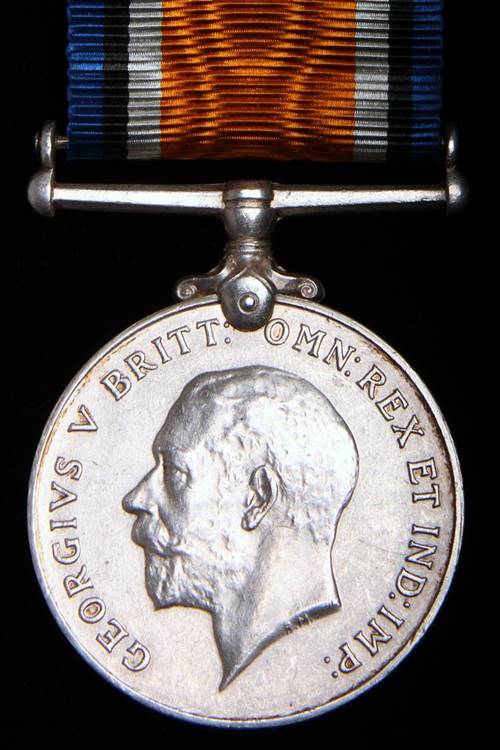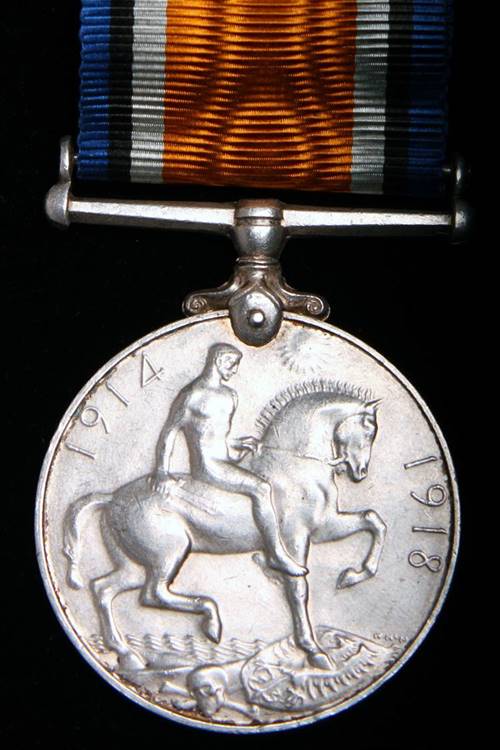This article is about the British War Medal and will explain what the medal is, why it was awarded and how it can help you research soldiers who served in the British Army during the First World War. I have written more articles on the other First World War campaign medals as well as guides to help you research British Army soldiers:
- 1914 Star
- 1914-15 Star
- Allied Victory Medal
- Guides to Researching soldiers who served in the British Army
British War Medal
The British War Medal was the most common British campaign medal of the First World War with over 6.5 million issued in silver and 100,000 in bronze. In essence to be awarded the medal, a soldier in the British Army had to serve outside of Britain and Ireland between 5 August 1914 and 11 November 1918. This was later extended to allow men who took part in post-war mine clearing, as well as operations in Russia against the Bolsheviks up until midnight on 1/2 July 1920. Any soldier serving abroad on the outbreak of war automatically qualified for the medal. The British War Medal could be a soldier’s sole medal entitlement and this is frequently the case for those garrisoning India and Burma.
The British War Medal was often referred to as the General Service Medal shortly after the war. General Service Medals were always issued with a clasp and while this was mooted for the British War Medal, with clasps for campaigns, lengths of service and battles, it was abandoned as too time-consuming and costly. Occasionally, unofficial clasps can be found on medals to naval personnel. The entry below was taken from the National Roll of the Great War which recorded all British War Medals as General Service Medals. Also, note how the 1914 Star has been referred to by its colloquial name, the Mons Star.
British War Medal Records
A British War Medal will help you research soldiers as there are two surviving records for them. There is a medal index card and the corresponding medal roll entry for the soldier. These documents recorded a soldier’s name, regiment or corps and a variety of other information, including on the medal roll, the battalions a soldier served with abroad. The exact units for soldiers who served in a corps, Royal Artillery, Royal Engineers etc. aren’t usually recorded on the medal roll.
A photograph of a soldier wearing the British War Medal riband (ribbon) can be very useful in identifying their regimental number if it isn’t already known. However, the British War Medal ribbon was sent separately from the Victory Medal so there is a possibility that the soldier qualified for both but hadn’t yet received their Victory Medal ribbon. The ribbon began to be issued from July 1919 onwards so is a good dating tool. Most soldiers qualified for the Victory Medal as well and a single ribbon is often a strong indicator that you’re looking a Territorial Force soldier. Unless you’re looking for a very common name, you can usually identify the correct regimental number and regiment by looking through all the medal rolls to identify the man who was only awarded the British War Medal. Ancestry has digitized both sets of documents.
Description of the British War Medal


Size: 36 mm.
Metal: Silver or bronze.
Naming: Impressed in block capitals around the rim. Medals awarded to civilian organisations, Young Men’s Christian Association, French Red Cross etc., also special agents, are only impressed with a name, usually initials and surname. Medals to officers will have their rank on the medal. British War Medals issued to the Merchant Marine only contained a name, though usually the first name is impressed in full.
Number Issued: Over 6.5 Million medals were struck in silver and 100,000 in bronze which were awarded to members of the Labour Corps and other units raised throughout the Empire. The bronze medals are very collectable and on average sell for at least five times the going rate of a silver British War Medal.
Designer: William McMillan, whose initials WMcM can be seen on the lower bust of King George’s head on the obverse and just above the shield on the reverse.
The Silver Bubble and the Loss of Thousands of British War Medals.
Of all the medals awarded for service during the First World War, the British War Medal has had the toughest journey. In the late 1970s, the Hunt family tried to corner the silver market, sending the price of silver skyrocketing from $6 per ounce to $48.70 per ounce in 1979. The cost of the medal in the 1970s was far below its scrap value and in consequence, many were bought just to be melted down for their silver content. Though the silver bubble burst in March 1980, it was too late for an unknown number of medals which had already been melted down. The consequence of the silver bubble can still be seen today, as many medal groups are missing the British War Medal or they are found with the suspender snapped off, due to this being made from an alloy, rather than solid silver.
Recent Mutilation of British War Medals
A more recent problem for the medal is the removal of the alloy suspender, usually on the medals of soldiers who served in the Army Service Corps or Royal Artillery, to be sold separately from the disc to repair more desirable medals. This is due to the lower prices commanded by British War Medal to men who served in the various corps of the British Army which leads to the mutilation of their medals for a couple more pounds profit.
British War Medals to Indian Soldiers
Considering the large numbers of British War Medals awarded to Indian soldiers for service during the First World War, they are not frequently encountered. If you were to pick a random Indian regiment who served abroad during the war and collect their medals, you will find at least six Victory Medals for every British War Medal. The high price of silver on the Indian subcontinent, where family wealth has traditionally been kept in precious metals, has meant that a high percentage of British War Medals issued have ended up being melted down. Occasionally, you will find a British War Medal with a deep cut to the rim, most likely caused by the blade of the local village jeweller testing its silver content. I have written a separate article on medals awarded to Indian soldiers during the First World War.

